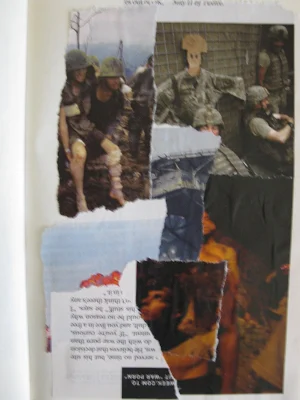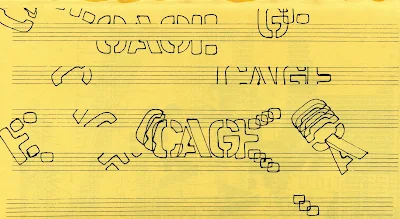 |
| The mountain in the distance, at Mount Royal and Park Avenue |
This is in response to Jason Camlot’s “After the Mountain; The A.M. Klein Reboot Project”. Klein’s original poem, “The Mountain”, is published below; it is followed by my cut-up of Klein’s poem, published in a chapbook of the same title, compiled and edited by Jason Camlot, and published by Synapse Press, Montreal, 2011:
For many years I have been interested in William Burroughs and Brion Gysins’ experiments in “cutting-up” texts. In this poem I have literally “re-mixed” A.M. Klein’s poem “The Mountain”. This “re-mix” is a fairly conservative cut-up of Klein’s original poem; that is, I have kept the integrity of Klein’s lines in tact but I have re-mixed the order of the lines. Klein’s text was cut-up with scissors and then randomly reassembled. The resulting “cut-up” text changes a straight linear poem—Klein’s lyrical “A Mountain”—reassembles or re-mixes the poem, and finds in the new text a similar lyrical expression as in Klein’s poem, but without the linearity of the original poem. Meaning persists, but it emerges strangely transformed by the re-mix.
Stephen Morrissey
14 November 2011
Klein’s original poem:
The Mountain
A.M. Klein
Who knows it only by the famous cross which bleeds
into the fifty miles of night its light
knows a night—scene;
and who upon a postcard knows its shape —
the buffalo straggled of the laurentian herd, —
holds in his hand a postcard.
In layers of mountains the history of mankind,
and in Mount Royal
which daily in a streetcar I surround
my youth, my childhood —
the pissabed dandelion, the coolie acorn,
green prickly husk of chestnut beneath mat of grass—
O all the amber afternoons
are still to be found.
There is a meadow, near the pebbly brook,
where buttercups, like once on the under of my chin
upon my heart still throw their rounds of yellow.
And Cartier's monument, based with nude figures
still stands where playing hookey
Lefty and I tested our gravel aim
(with occupation flinging away our guilt)
against the bronze tits of Justice.
And all my Aprils there are marked and spotted
upon the adder's tongue, darting in light,
upon the easy threes of trilliums, dark green, green, and white,
threaded with earth, and rooted
beside the bloodroots near the leaning fence—
corms and corollas of childhood,
a teacher's presents.
And chokecherry summer clowning black on my teeth!
The birchtree stripped by the golden zigzag still
stands at the mouth of the dry cave where I
one suppertime in August watched the sky
grow dark, the wood quiet, and then suddenly spill
from barrels of thunder and broken staves of lightning —
terror and holiday!
One of these days I shall go up to the second terrace
to see if it still is there—
the uncomfortable sentimental bench
where, — as we listened to the brass of the band concerts
made soft and to our mood by dark and distance—
I told the girl I loved
I loved her.
The Mountain, Re-mix One
Stephen Morrissey
O all the amber afternoons
are still to be found.
And all my Aprils there are marked and spotted
upon the adder’s tongue, darting in light,
the pissabed dandelion, the coolie acorn,
green prickly husk of chestnut beneath mat of grass —
from barrels of thunder and broken staves of lightning —
terror and holiday!
Who knows it only by the famous cross which bleeds
into fifty miles of night its light
upon the easy threes of trillium, dark, green, and white,
threaded with earth, and rooted
And Cartier’s monument, based with nude figures
still stands where playing hookey
Lefty and I tested our gravel aim
(with occupation flinging away our guilt)
holds in his hand a postcard.
In layers of mountains the history of mankind,
and in Mount Royal
There is a meadow, near the pebbly brook,
where buttercups, like once on the under of my chin
a teacher’s presents.
And chokecherry summer clowning black on my teeth!
One of these days I shall go up to the second terrace
to see if it is still there—
one suppertime in August watched the sky
grow dark, the wood quiet, and then suddenly spill
The birch tree stripped by the golden zigzag still
stands at the mouth of the dry cave where I
which daily in a streetcar I surround
my youth, my childhood—
against the bronze tits of Justice.
the uncomfortable sentimental bench
where, —as we listened to the brass of the band concerts
knows a night-scene;
and who upon a postcard knows its shape —
the buffalo straggled of the laurentian herd, —
upon my heart still throw their rounds of yellow.
made soft and to our mood by dark and distance —
I told the girl I loved
I loved her.
beside the bloodroots near the leaning fence—
corms and corollas of childhood.
The Mountain, Re-mix Two, unpublished
Stephen Morrissey
one suppertime in August watched the sky
grow dark, the wood quiet, and then suddenly spill
a night-scene;
and who upon a postcard knows its shape
stands at the mouth of a dry cave where I
beside the bloodroots near the leaning fence—
corms and corollas of childhood,
against the bronze tits of Justice.
And all my Aprils there are marked and spotted
the pissabed dandelion, the coolie acorn,
green prickly husk of chestnut beneath mat of grass—
There is a meadow, near the pebbly brook,
where buttercups, like once on the under of my chin
The birchtree striped by the golden zigzag still
(with occupation flinging away our guilt)
and in Mount Royal
which daily in a streetcar I surround
holds in his hand a postcard.
In layers of mountains the history of mankind,
into the fifty miles of night
from barrels of thunder and broken staves of lightning—
terror and holiday!
upon the adder’s tongue, darting in light,
upon the easy threes of trilliums, dark, green, and white,
One of these days I shall go to the second terrace
upon my heart still throw their rounds of yellow..
And Cartier’s monument, based with nude figures
Who knows it only by the famous cross which bleeds
threaded with earth, and rooted
to see if it still is there—
the uncomfortable sentimental bench
still stands where playing hookey
Lefty and I tested our gravel aim
my youth, my childhood—
O all the amber afternoons
are still to be found.
where,—as we listened to the brass of the band concerts
made soft and to our mood by dark and distance—
I told the girl I loved
And chokecherry summer clowning on my teeth
the buffalo straggled of the laurentian herd,—
a teacher’s presents.
I loved her.
11 November 2011




























